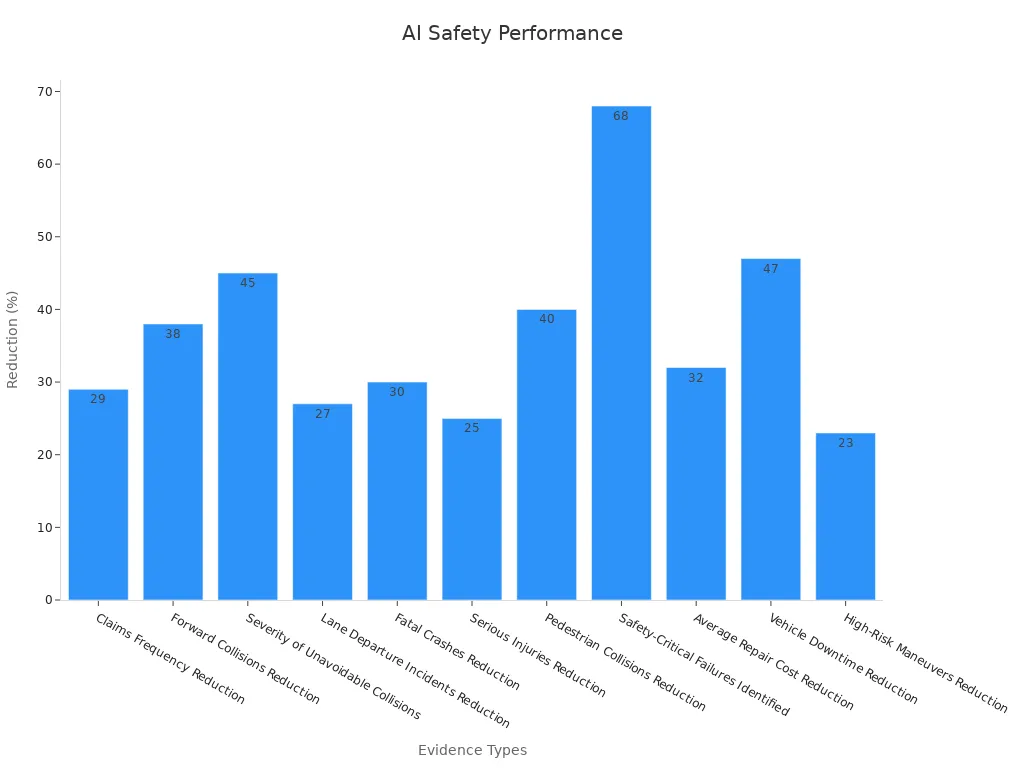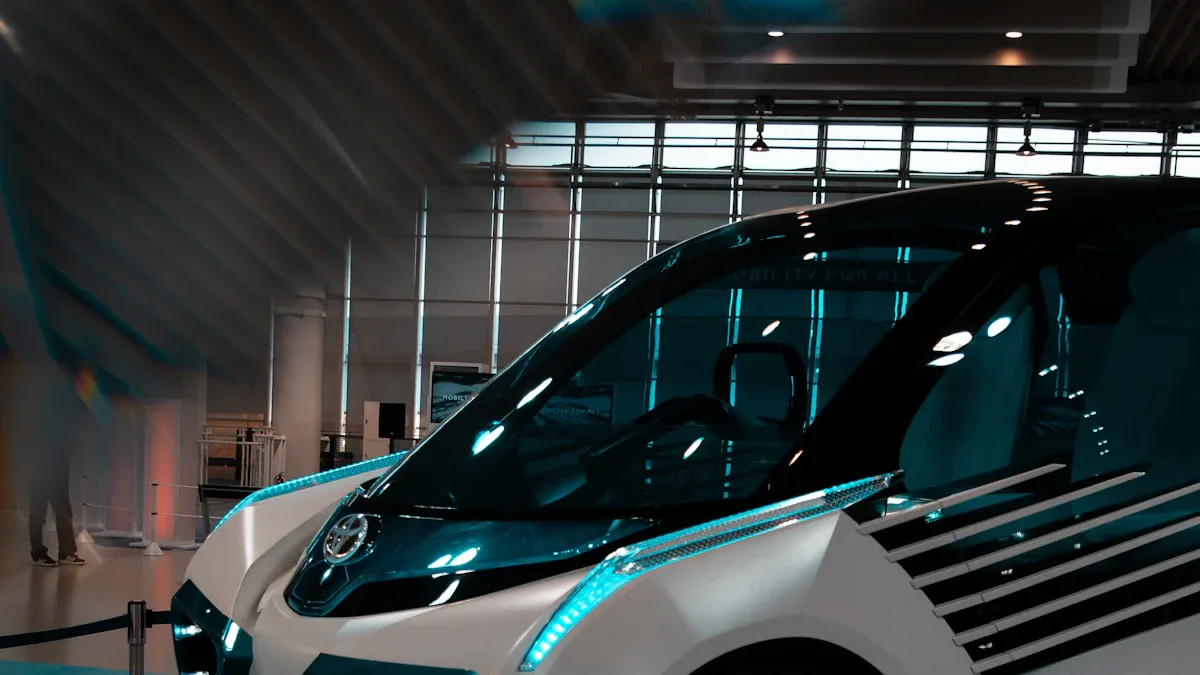How AI is Shaping the Future of Vehicle Systems in 2025

Artificial intelligence has become a game-changer in the automotive industry, redefining safety, efficiency, and user experience. Vehicles equipped with AI technologies now feature advanced systems like predictive maintenance, which reduces annual maintenance costs by 10% and downtime by 20%. Additionally, AI-driven security measures enhance parking accuracy and operational flow. The integration of AI has also led to a surge in connected vehicles, with their market share climbing to 97% by 2023. These advancements highlight how AI is transforming the way vehicles operate and interact with drivers, paving the way for a smarter future in transportation.
Key Takeaways
AI makes cars safer by helping prevent accidents. It can lower crashes by up to 90%.
AI helps fix cars before they break down. This saves 32% on repair costs and cuts surprise breakdowns by 47%.
Cars now use voice commands with AI. This makes driving easier and less distracting.
Self-driving cars, powered by AI, will change how we travel. These cars are expected to grow in popularity soon.
AI entertainment systems adjust to what you like. They make trips more fun and personal.
The Current Role of AI in Automotive Systems
AI in driver assistance and safety features
AI is revolutionizing driver assistance systems, making vehicles safer and smarter. Advanced Driver Assistance Systems (ADAS) use AI to monitor road conditions and provide real-time safety alerts. These systems reduce accidents by up to 90%, saving thousands of lives annually. Machine learning algorithms enhance detection accuracy, reducing false alerts by 60% and increasing true positives by 35%. Features like lane-keeping assistance prevent lane-departure accidents, cutting incidents by 30%. AI also addresses driver fatigue, a factor in 20% of road accidents, by monitoring behavior and issuing timely warnings. These advancements highlight how AI applications are transforming automotive safety.
Natural language processing for seamless in-car communication
Natural language processing (NLP) is a key AI technology in modern vehicles. It enables drivers to interact with cars through voice commands, improving user experience. AI-powered virtual assistants, present in over 40% of new vehicles, assist with navigation, music selection, and climate control. These systems process real-time data to understand context and respond accurately. For example, a driver can ask for the nearest gas station, and the system provides directions instantly. NLP enhances safety by minimizing distractions, allowing drivers to focus on the road. This integration of AI in automotive technology ensures smoother and safer driving experiences.
Context-aware systems for smarter and adaptive driving
Context-aware systems use AI to analyze real-time data from sensors and cameras, adapting to changing driving conditions. These systems monitor driver behavior, road conditions, and vehicle performance to enhance safety and efficiency. For instance, they detect reckless driving or fatigue and issue safety alerts to prevent accidents. Studies show that such systems significantly reduce accident severity and improve decision-making. Additionally, monitoring driving patterns can lead to insurance discounts for safe drivers. By leveraging AI integration, context-aware systems make driving more adaptive and responsive, setting a new standard in automotive technology.
Advancements in AI-Powered Cars

Autonomous driving technologies and self-driving cars
Autonomous vehicles are at the forefront of automotive innovation, driven by advancements in AI. Companies like Tesla, General Motors, and Volkswagen are leading the charge in developing self-driving cars equipped with cutting-edge AI systems. Tesla's Autopilot system, for instance, showcases how AI enhances both safety and convenience. These vehicles rely on AI to process vast amounts of data from sensors, cameras, and radar systems, enabling real-time decision-making.
The adoption of autonomous driving hardware has grown significantly over the years. The table below highlights this trend:
Year | Number of Vehicles Equipped with Fully Autonomous Driving Hardware |
|---|---|
2018 | 137,129 |
2019 | 332,932 |
2020 | 390,662 |
2021 | 508,622 |
2022 | 638,585 |
2023 | 745,705 |

The global autonomous vehicles market reached $208 billion in 2023 and is projected to grow to $4,206.4 billion by 2032. These figures underscore the rapid evolution of autonomous driving technology and its potential to revolutionize transportation.
🚗 Top AI Chips Used in Cars
AI chips play a crucial role in enabling autonomous driving and other advanced automotive systems. Here are some of the most prominent AI chips used in the industry:
NVIDIA Drive Series: Used by Mercedes-Benz and Volvo for Level 3–5 autonomy.
Tesla Full Self-Driving Chip: Optimized for Tesla's neural network processing.
Mobileye EyeQ Series: Popular for ADAS and camera processing.
Qualcomm Snapdragon Ride: Scalable for Level 1 to Level 5 systems.
Horizon Robotics Journey Series: Widely used in China for perception and ADAS.
AI-driven safety systems, including collision prevention and driver monitoring
AI-driven technologies are transforming safety in the automotive sector. Enhanced safety features like collision prevention and driver monitoring systems are reducing accidents and saving lives. Predictive Advanced Driver Assistance Systems (ADAS) have demonstrated remarkable results, including a 38% reduction in forward collisions and a 30% decrease in fatal crashes. These systems analyze real-time data to identify risks and provide timely warnings.
The table below highlights the impact of AI-driven safety systems:
Evidence Type | Statistic/Impact |
|---|---|
Forward Collisions Reduction | 38% fewer with predictive ADAS |
Fatal Crashes Reduction | 30% reduction in vehicles with predictive systems |
Pedestrian Collisions Reduction | 40% reduction |
Economic Savings | $18 billion annually in accident-related costs |
High-Risk Maneuvers Reduction | 23% reduction after three months of system use |

Driver monitoring systems also play a vital role in improving safety. These systems detect signs of fatigue or distraction and issue alerts to prevent accidents. By leveraging AI, automotive manufacturers are creating smarter systems that adapt to driver behavior and road conditions, ensuring a safer driving experience.
Predictive maintenance for enhanced vehicle reliability
Predictive maintenance is another area where AI is making a significant impact. By analyzing data from sensors and onboard diagnostics, AI systems can identify potential issues before they lead to failures. This proactive approach reduces unplanned downtime by 47% and lowers maintenance costs by 32%. It also extends the lifespan of vehicle components, improving overall reliability.
The table below outlines the benefits of predictive maintenance:
Metric | Benefit Description |
|---|---|
Reduces Maintenance Cost | Early identification of issues minimizes downtime and emergency repairs, leading to significant cost savings. |
Extended Equipment Lifespan | Condition-based maintenance optimizes resource allocation and prolongs the life of equipment. |
Reduce Unplanned Downtime | Proactive repairs prevent unexpected failures, ensuring continuous operations and improved reliability. |
Increased Operational Efficiency | Streamlined operations and reduced troubleshooting times enhance overall system performance. |
Improved Safety | Early detection of potential failures reduces workplace hazards and promotes compliance with safety standards. |
General Motors has successfully implemented predictive maintenance in its vehicles, significantly improving customer satisfaction. AI-powered systems monitor vehicle performance in real time, ensuring that repairs are scheduled at the most convenient times. This approach not only enhances reliability but also contributes to a better ownership experience.
Personalized user experiences through AI-powered infotainment
AI-powered infotainment systems are transforming the way drivers and passengers interact with vehicles. These systems leverage artificial intelligence to deliver personalized experiences that cater to individual preferences, making every journey more enjoyable and efficient.
Modern infotainment platforms analyze real-time data to understand user habits and preferences. For instance, AI can recommend music playlists based on listening history or suggest navigation routes tailored to frequent destinations. This level of customization enhances convenience and ensures that users feel more connected to their vehicles.
🚀 Did you know?
In 2025, hyper-personalized experiences will dominate the automotive industry. Consumers will expect tailored offers and services, such as customized lease options and infotainment systems that recognize their unique preferences.
AI-driven infotainment systems also improve user engagement by creating seamless interactions. Voice recognition technology allows drivers to control features like climate settings, navigation, and entertainment without taking their hands off the wheel. This reduces distractions and enhances safety while maintaining a personalized touch.
Key Benefits of AI-Powered Infotainment Systems
Customized Recommendations: AI suggests music, podcasts, and other media based on user preferences.
Tailored Navigation: Systems provide routes optimized for individual driving patterns and habits.
Enhanced Safety: Voice-controlled features minimize distractions, allowing drivers to focus on the road.
Real-Time Personalization: AI adapts to changing preferences, ensuring a dynamic and engaging experience.
AI's ability to utilize real-time data extends beyond entertainment. It enables predictive personalization, which has proven to boost profitability for organizations. One-third of companies using this technology report profit increases of over 10%. This trend highlights the growing demand for tailored experiences in the automotive sector.
North American car dealers have also embraced AI-powered chat features on their websites, enhancing consumer perception of car retail. Over 90% of dealerships now use these tools to provide personalized assistance, reflecting the broader shift toward AI-driven customer experiences.
As vehicles become smarter, AI-powered infotainment systems will continue to redefine personalization. From customized music playlists to navigation routes that align with user habits, these systems ensure that every drive feels uniquely tailored to the individual.
Future Implications of AI in the Automotive Industry

Transforming road safety and reducing accidents
AI in the automotive sector is revolutionizing road safety by minimizing accidents and enhancing emergency response. Advanced AI solutions analyze real-time data from sensors and cameras to detect potential hazards. These systems issue timely alerts, helping drivers avoid collisions. Automated accident detection further improves safety by enabling quicker response times. For example, AI tools assess crash severity within minutes, expediting claims processing and repairs.
AI-driven safety systems also reduce human error, which accounts for 94% of traffic accidents. Features like adaptive cruise control and automatic emergency braking prevent high-risk maneuvers. Pedestrian detection systems powered by AI have reduced pedestrian collisions by 40%. These advancements highlight the significant impact of AI in automotive safety.
🚨 Did you know?
AI tools can visually assess vehicle damage through images, providing cost estimates and saving time for insurers and repair shops.
The benefits of AI in automotive safety extend beyond accident prevention. By integrating AI solutions, manufacturers are creating smarter systems that adapt to driver behavior and road conditions. This approach ensures a safer and more reliable driving experience for all road users.
Enhancing fuel efficiency and environmental sustainability
AI is playing a crucial role in improving fuel efficiency and promoting environmental sustainability in the automotive industry. By optimizing vehicle performance, AI systems reduce fuel consumption and emissions. Companies like UPS and FedEx have already achieved significant savings through AI-driven route optimization.
Company | Fuel Efficiency Improvement | Annual Savings/Reduction |
|---|---|---|
UPS | 10 million gallons saved | $300-$400 million |
FedEx | 10% reduction in costs | N/A |
DHL | 25% energy cost reduction | N/A |
Maersk | 15% fuel cost savings | N/A |
General | 15% decrease in consumption | 20% reduction in costs |
AI in automotive systems also supports the transition to electric vehicles (EVs). Bosch, for instance, uses AI to enhance battery management in EVs, extending battery life and improving energy efficiency. This innovation aligns with the industry's focus on electrification and zero-emission technologies.
🌱 Tip for the Future:
Electrification and AI integration will drive the automotive sector toward a greener future, reducing the environmental impact of transportation.
By leveraging AI solutions, the automotive industry is not only enhancing fuel efficiency but also contributing to global sustainability goals. These advancements demonstrate the long-term benefits of AI in creating a cleaner and more efficient transportation system.
Revolutionizing the driving experience with fully autonomous vehicles
The rise of fully autonomous vehicles is set to redefine the overall driving experience. AI-powered systems enable self-driving cars to process vast amounts of data from sensors, cameras, and radar. This technology allows vehicles to make real-time decisions, ensuring a safer and more efficient journey.
The autonomous vehicle market is expanding rapidly, with projections indicating significant growth in the coming years:
Projection Year | Market Value (in billions) | Percentage of Cars with Advanced Tech |
|---|---|---|
Next 10 years | 300 - 400 | N/A |
By 2030 | N/A | 20% |
By 2035 | N/A | 57% |
Waymo's use of AI for fully autonomous ride-hailing services showcases the practical application of this technology. These services improve transportation efficiency and reduce traffic congestion. Additionally, 51% of car buyers are likely to switch to fully autonomous vehicles in the future, reflecting growing consumer interest.
AI in automotive systems also enhances the driving experience through advanced features like personalized infotainment and predictive maintenance. These innovations ensure that vehicles cater to individual preferences, making every journey more enjoyable.
The future of autonomous vehicles holds immense potential. As AI technology continues to evolve, it will transform the automotive sector, creating a safer, smarter, and more connected driving experience.
Addressing ethical and regulatory challenges in AI adoption
The adoption of artificial intelligence in the automotive industry has introduced significant ethical and regulatory challenges. As AI systems become more integrated into vehicles, addressing these issues is essential to ensure safety, fairness, and compliance with global standards.
One major concern involves AI bias and fairness. AI systems rely on data to make decisions, but biased datasets can lead to unfair outcomes. For example, facial recognition systems in driver monitoring may perform poorly for certain demographics, raising questions about equity. To mitigate this, developers must implement fairness-aware algorithms that minimize bias and ensure inclusivity.
Regulatory uncertainty also poses challenges for the automotive sector. Governments worldwide are introducing new laws to govern AI-driven systems, but these regulations often vary by region. Compliance with evolving safety, environmental, and cybersecurity standards is critical. For instance, ISO 26262 ensures that AI-powered Advanced Driver Assistance Systems meet stringent vehicle safety requirements. Adhering to such standards helps manufacturers build trust and maintain accountability.
Data privacy regulations further complicate AI adoption. Laws like the General Data Protection Regulation (GDPR) in Europe and the California Consumer Privacy Act (CCPA) in the United States regulate how AI systems process customer data. These laws require transparency in data collection and usage, ensuring that predictive analytics respect user privacy. Automotive companies must prioritize secure data handling to avoid legal repercussions and maintain consumer confidence.
The European Union's AI Act highlights another layer of regulatory complexity. This legislation identifies high-risk AI applications, such as autonomous driving systems, and mandates bias audits and human oversight. By enforcing these measures, the AI Act aims to prevent misuse and promote ethical AI deployment in the automotive industry.
🚨 Note: Ethical AI adoption is not just a technical challenge; it is a societal responsibility. Developers, regulators, and manufacturers must collaborate to create systems that prioritize safety, fairness, and transparency.
Addressing these challenges requires a proactive approach. Automotive companies must invest in research to develop unbiased algorithms and ensure compliance with global standards. Collaboration with regulators can help shape policies that balance innovation with public safety. By tackling these issues head-on, the industry can pave the way for responsible AI integration in vehicles.
AI is revolutionizing the automotive industry by enhancing safety, efficiency, and user experiences. Its integration into vehicle systems has led to groundbreaking advancements across multiple areas:
Aspect | Impact |
|---|---|
Safety Enhancements | AI reduces accidents by addressing human error through autonomous systems. |
Maintenance Costs | Optimized schedules prevent unnecessary repairs, saving time and money. |
Transportation Efficiency | Autonomous vehicles improve route planning, reducing fuel consumption and emissions. |
Customer Experience | AI anticipates user needs, delivering personalized and seamless interactions. |
These innovations highlight AI's transformative role in shaping the future of transportation. As technology evolves, its potential to redefine mobility and urban landscapes will only grow.
What is the role of AI in improving vehicle safety?
AI enhances vehicle safety by analyzing real-time data from sensors and cameras. It powers features like collision prevention, lane-keeping assistance, and driver monitoring. These systems reduce accidents caused by human error, making roads safer for everyone.
How does AI contribute to fuel efficiency?
AI optimizes fuel efficiency by analyzing driving patterns and suggesting energy-saving routes. It also improves vehicle performance through predictive maintenance and better engine management. Companies using AI for route optimization have reported significant reductions in fuel consumption and emissions.
Are fully autonomous vehicles safe to use?
Fully autonomous vehicles rely on advanced AI systems to process data and make decisions. These systems reduce human error, which causes most accidents. While still evolving, autonomous vehicles have shown promising safety improvements in controlled environments and pilot programs.
How does AI personalize the driving experience?
AI-powered infotainment systems analyze user preferences to deliver personalized recommendations. These systems suggest music, navigation routes, and climate settings tailored to individual habits. Voice recognition further enhances convenience by allowing hands-free control of vehicle features.
What challenges does AI face in the automotive industry?
AI adoption in vehicles faces challenges like data privacy concerns, regulatory compliance, and ethical issues. Developers must address biases in AI algorithms and ensure systems meet global safety standards. Collaboration between manufacturers and regulators is essential for responsible AI integration.
See Also
Explore The Essential Automotive Features Of FREESCALE MCF5251CVM140
Three Innovative Approaches Of ATIC83E2 In Industrial Automation
Ways Booming Technology Ensures Excellence In The Electronics Sector
AD9736BBCZ: Pioneering The Next Era Of Wireless Communication
RV1126 Fuels AI-Driven Edge Computing For Robotics Applications
CALL US DIRECTLY
(+86)755-82724686
RM2508,BlockA,JiaheHuaqiangBuilding,ShenNanMiddleRd,Futian District,Shenzhen,518031,CN
www.keepboomingtech.com sales@keepboomingtech.com
